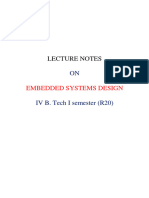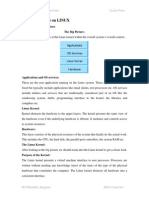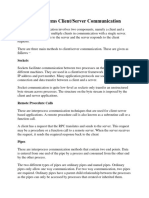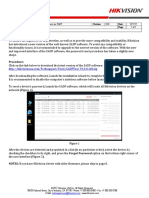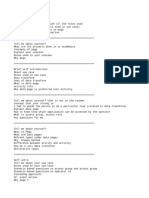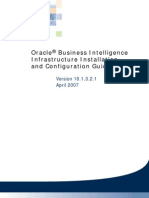Professional Documents
Culture Documents
Dc-Os Arch
Dc-Os Arch
Uploaded by
Sandra Maria0 ratings0% found this document useful (0 votes)
46 views14 pagesThis document discusses operating system architectures for distributed systems, focusing on monolithic and microkernel designs. A monolithic kernel implements many operating system services within the kernel itself, making it large and difficult to modify. A microkernel moves most OS services into userspace servers that communicate with the microkernel via messages. This allows services to be added or replaced more easily and enforces modularity. The document compares advantages of the two approaches, noting extensibility and potential for fewer bugs with microkernels, while monolithic kernels can have higher performance due to avoiding inter-process communication.
Original Description:
dc os architecture short introduction
Original Title
dc-os arch
Copyright
© © All Rights Reserved
Available Formats
PPT, PDF, TXT or read online from Scribd
Share this document
Did you find this document useful?
Is this content inappropriate?
Report this DocumentThis document discusses operating system architectures for distributed systems, focusing on monolithic and microkernel designs. A monolithic kernel implements many operating system services within the kernel itself, making it large and difficult to modify. A microkernel moves most OS services into userspace servers that communicate with the microkernel via messages. This allows services to be added or replaced more easily and enforces modularity. The document compares advantages of the two approaches, noting extensibility and potential for fewer bugs with microkernels, while monolithic kernels can have higher performance due to avoiding inter-process communication.
Copyright:
© All Rights Reserved
Available Formats
Download as PPT, PDF, TXT or read online from Scribd
Download as ppt, pdf, or txt
0 ratings0% found this document useful (0 votes)
46 views14 pagesDc-Os Arch
Dc-Os Arch
Uploaded by
Sandra MariaThis document discusses operating system architectures for distributed systems, focusing on monolithic and microkernel designs. A monolithic kernel implements many operating system services within the kernel itself, making it large and difficult to modify. A microkernel moves most OS services into userspace servers that communicate with the microkernel via messages. This allows services to be added or replaced more easily and enforces modularity. The document compares advantages of the two approaches, noting extensibility and potential for fewer bugs with microkernels, while monolithic kernels can have higher performance due to avoiding inter-process communication.
Copyright:
© All Rights Reserved
Available Formats
Download as PPT, PDF, TXT or read online from Scribd
Download as ppt, pdf, or txt
You are on page 1of 14
1
Operating System Architecture and
Distributed Systems
Let us look into the architecture of a
kernel suitable for a distributed system.
A key principle of DS is openness and
with this in mind let us examine the
major kernel architectures:
Monolithic kernels
Micro-kernels
2
Open DS and System Software
A open DS should make it possible to:
Run only that system software at each computer
that is necessary for its particular role in the system
architecture. For example, system software needs of
PDA and dedicated server are different and loading
redundant modules wastes memory resources.
Allow the software (and the computer) implementing
any particular service to be changed independent of
other facilities.
Allow for alternatives of the same services to be
provided, when this is required to suit different users
or applications.
Introduce new services without harming the integrity
of existing ones.
3
Separating Mechanisms and Policies
in OS and DS
A Guiding principle of OS design:
The separation of fixed resource management mechanisms
from resource management policies, which vary from
application to application and service to service.
For example, an ideal scheduling system would provide
mechanisms that enable a multimedia application such
as videoconferencing to meet its real-time demands
while coexisting with a non-real-time application such
as web browsing.
That is kernel would provide only the most basic
mechanisms upon which the general resource
management tasks at a node are carried out.
Server modules would be dynamically loaded as
required, to implement the required RM policies for the
currently running applications.
4
OS/Kernel Architecture
The two key examples of kernel design approaches are:
Monolithic
Microkernel
Basically these two designs differ primarily in the
decision as to what functionality belongs in the kernel
and what is left to server processes that can be
dynamically loaded to run on top of it.
In Literature, we find predominantly 3 types of OS:
Monolithic OS
Layered OS
Microkernel-based OS
The first two may be put under the same category as
monolithic.
The chambers 20
th
century dictionary definition of monolithic
is: a pillar, column, of a single stone: anything that resembling
a monolithic, massiveness.
5
Monolithic kernel and microkernel
Monolit hic Kernel Microkernel
Serv er: Dy namically loaded server program: Kernel code and data:
. .. . .. .
. .. . .. .
Key:
S4
S1
. .. . .. .
S1 S2 S3
S2 S3 S4
6
Application
Programs
Application
Programs
System Services
Hardware
User Mode
Kernel Mode
Monolithic Operating System
Better application Performance
Difficult to extend
Ex: MS-DOS
7
Traditional OS
OS Designer
OS
Hardware
User Mode
Kernel Mode
Application
Programs
Application
Programs
8
Disadvantages of Monolithic OS
It is massive:
It performs all basic OS functions and takes up in
the order of megabytes of code and data
It is undifferentiated:
It is coded in a non-modular way (traditionally)
although modern ones are much more layered.
It is intractable:
Altering any individual software component to adapt
it to changing requirements is difficult.
9
New trend in OS design: Separating
mechanisms and policies
User Mode
Kernel Mode
Hardware
Microkernel
(very basic functions)
Servers
Application
Programs
Application
Programs
10
Micro-kernel
Compared to monolithic, microkernel design
provides only the most basic abstractions,
principally address space, threads and local IPC.
All other system services are provided by
servers that are dynamically loaded precisely on
those computers in the DS that require them.
Clients access these system services using the
kernels message-based invocation
mechanisms.
11
Microkernel/Client Server OS
Tiny OS kernel providing basic primitive (process, memory, IPC)
Traditional services becomes subsystems
OS = Microkernel + User Subsystems
Client
Application
OS
Emulators
File
Server
Network
Server
Display
Server
Microkernel
Hardware
User
Kernel
Send
Reply
Ex: Mach, PARAS, Chorus, etc.
12
The role of the microkernel
MK appears as a layer between H/W and
system systems.
Middleware
Language
support
subsyst em
Language
support
subsyst em
OS emulat ion
subsyst em
....
Microkernel
Hardware
The microkernel support s middleware via subsystems
13
Few Popular Microkernel Systems
MACH, CMU
It supports different OS emulators
including Unix and OS/2.
PARAS, C-DAC
Chorus
QNX,
Windows NT original design.
14
Comparison: Monolithic and
Micro-kernel OS Design
The chief advantages of a MK-based OS:
Extensibility and its ability to enforce modularity
behind memory protection boundaries
A relative small kernel is more likely to be free of
bugs than one that is larger and complex.
The advantage of a monolithic OS:
Relative efficiency with which operations can be
invoked is high because even invocation to a
separate user-level address space on the same node
is more costly.
You might also like
- Infor Mongoose IDO Development Guide PDFDocument70 pagesInfor Mongoose IDO Development Guide PDFmgdesouzaNo ratings yet
- Best O.S and Tools To Learn HackingDocument2 pagesBest O.S and Tools To Learn HackingPradip Kr SharmaNo ratings yet
- Quick Start Guide: Bitbox / BiteditDocument3 pagesQuick Start Guide: Bitbox / BiteditObd King TgiNo ratings yet
- L5 OS DS ArchDocument19 pagesL5 OS DS ArchLilian NjokiNo ratings yet
- L5 OS DS ArchDocument20 pagesL5 OS DS ArchAbhishek DamaniNo ratings yet
- OS StructureDocument25 pagesOS StructureABDUL QUDOOSNo ratings yet
- OS 02 ArchitectureDocument63 pagesOS 02 ArchitectureSUSHANTA SORENNo ratings yet
- Sub:-Operating System Sub Code: - 14B11CI511Document18 pagesSub:-Operating System Sub Code: - 14B11CI511Rishi JainNo ratings yet
- Distributed Sysytem Software ConceptsDocument21 pagesDistributed Sysytem Software ConceptsbalajiNo ratings yet
- Note On Operating System and KernelDocument3 pagesNote On Operating System and Kernelobinna benjaminNo ratings yet
- 5.study Experiment On NOS and DOSDocument9 pages5.study Experiment On NOS and DOSShashank GosaviNo ratings yet
- Kernel PresentationDocument30 pagesKernel PresentationArslan HaiderNo ratings yet
- A Survey of Embedded Operating SystemDocument7 pagesA Survey of Embedded Operating Systemkvamsee112No ratings yet
- Deliverable 1Document8 pagesDeliverable 1Nate TeBlunthuisNo ratings yet
- Operating SystemsDocument22 pagesOperating SystemsRajdeep BorgohainNo ratings yet
- 1.1 OS Struture, Operations and TypesDocument47 pages1.1 OS Struture, Operations and TypesVIJAYA PRABA PNo ratings yet
- Esd 4Document40 pagesEsd 40442- TARUNNo ratings yet
- Kernel Definition: of Memory, Which Prevents It From Being Overwritten by Other, Less Frequently UsedDocument6 pagesKernel Definition: of Memory, Which Prevents It From Being Overwritten by Other, Less Frequently Usedbro4856No ratings yet
- Introduction Operating SystemDocument2 pagesIntroduction Operating SystemSơn Nguyễn VănNo ratings yet
- Chapter 1: Introduction: (OS Structure, Modes and Services)Document58 pagesChapter 1: Introduction: (OS Structure, Modes and Services)Nikhil TataNo ratings yet
- Introduction To Real-Time ConceptsDocument58 pagesIntroduction To Real-Time Conceptsaj9941506796No ratings yet
- Operating StructureDocument7 pagesOperating StructureVaibhav PearsonNo ratings yet
- Wy ISPKfgj HGR HNBMDocument10 pagesWy ISPKfgj HGR HNBMrezkyNo ratings yet
- FALLSEM2014-15 CP0567 28-Aug-2014 RM01 Unit-VDocument49 pagesFALLSEM2014-15 CP0567 28-Aug-2014 RM01 Unit-VnaumikrishnaNo ratings yet
- Symmetric Multiprocessing and MicrokernelDocument6 pagesSymmetric Multiprocessing and MicrokernelManoraj PannerselumNo ratings yet
- Linux KernelDocument9 pagesLinux KernelNavneetMishraNo ratings yet
- Embedded SystemDocument61 pagesEmbedded SystemsyashujioNo ratings yet
- Module 05Document50 pagesModule 05rekharaju041986No ratings yet
- Operating System Structure - Lesson 4 - 3Document5 pagesOperating System Structure - Lesson 4 - 3Bright Alike ChiwevuNo ratings yet
- OS ASS 1 (Solved)Document7 pagesOS ASS 1 (Solved)Muhammad MaazNo ratings yet
- CMP320 Operating Systems Operating System Structures: FALL 2017 Syed Abrar AhmadDocument27 pagesCMP320 Operating Systems Operating System Structures: FALL 2017 Syed Abrar AhmadArXlanNo ratings yet
- MINIX 3: A Case Study in More Reliable Operating SystemsDocument5 pagesMINIX 3: A Case Study in More Reliable Operating SystemsRiaz MunshiNo ratings yet
- AssignmentDocument10 pagesAssignmentSyeda Subhana HashmiNo ratings yet
- Computer For Art (CFA) (0) Pkg.g.i.o.k.hj V Hippopotamus Kohinoor GDocument43 pagesComputer For Art (CFA) (0) Pkg.g.i.o.k.hj V Hippopotamus Kohinoor Gpreciousdominic93No ratings yet
- 15877091881capse0401-Unit-4-App. of Os O.SDocument11 pages15877091881capse0401-Unit-4-App. of Os O.Sezhilarasu2k9No ratings yet
- Notes Chapter 1 Dfc2063-Dec2018Document94 pagesNotes Chapter 1 Dfc2063-Dec2018ain amirNo ratings yet
- UNIT4 - Embedded System RTOS 1 - JP PDFDocument41 pagesUNIT4 - Embedded System RTOS 1 - JP PDFsachin rajputNo ratings yet
- Advanced Computer Architecture SlidesDocument105 pagesAdvanced Computer Architecture SlidesShivansh JoshiNo ratings yet
- Chapter 1 - IntroductionDocument27 pagesChapter 1 - Introductionhhbw10No ratings yet
- Module 20: More On LINUX: Linux Kernel Architecture The Big PictureDocument39 pagesModule 20: More On LINUX: Linux Kernel Architecture The Big PictureAnkit SanghviNo ratings yet
- Introduction To OS & UnixDocument72 pagesIntroduction To OS & UnixmwandidaNo ratings yet
- Session - 2 - Lecture Notes - Operating-System Design Approaches PDFDocument15 pagesSession - 2 - Lecture Notes - Operating-System Design Approaches PDFAvinash AllaNo ratings yet
- MCS-022 Operating System Concepts andDocument29 pagesMCS-022 Operating System Concepts andSumit RanjanNo ratings yet
- CS211 Lec 4Document32 pagesCS211 Lec 4Muhammad RafayNo ratings yet
- Unit 1Document8 pagesUnit 1SanketNo ratings yet
- BE Comps DC Week1Document67 pagesBE Comps DC Week1Tejas BhanushaliNo ratings yet
- EdiDocument3 pagesEdiSalahadin AssefaNo ratings yet
- 1-1 Into To Distributed SystemsDocument10 pages1-1 Into To Distributed SystemsHarrison NchoeNo ratings yet
- Client Server OS Model (Part 1)Document2 pagesClient Server OS Model (Part 1)GeorgePapaloukasNo ratings yet
- Case StudyDocument17 pagesCase StudySumeet KaurNo ratings yet
- Kernel: in Operating SystemsDocument53 pagesKernel: in Operating SystemsAhmad RazaNo ratings yet
- Monolithic Kernels and Micro-KernelsDocument2 pagesMonolithic Kernels and Micro-KernelsShaurya KapoorNo ratings yet
- What Is An Operating System?: 1. Microsoft WindowsDocument10 pagesWhat Is An Operating System?: 1. Microsoft WindowsNova CadienteNo ratings yet
- Homework Title/No: 1 Course Code: CAP 614Document18 pagesHomework Title/No: 1 Course Code: CAP 614Surendra ChauhanNo ratings yet
- 205 3rd ClassDocument6 pages205 3rd ClassamakaidakariNo ratings yet
- Windows Vs LinuxDocument21 pagesWindows Vs LinuxrameshkkrliveNo ratings yet
- UNIT-1 Introduction To Linux Operating System 1. What Is An Operating System and Types of Operating SystemsDocument27 pagesUNIT-1 Introduction To Linux Operating System 1. What Is An Operating System and Types of Operating Systemsprudhvi saiNo ratings yet
- Unit1 Operating SystemDocument25 pagesUnit1 Operating SystemPoornima.BNo ratings yet
- Unit 2 KernelDocument7 pagesUnit 2 Kernelmhrznrabin5No ratings yet
- Assignment No1Document6 pagesAssignment No1hajimastanbaapNo ratings yet
- Research Notes of MSPDocument27 pagesResearch Notes of MSPshailendra shindeNo ratings yet
- Linux: A Comprehensive Guide to Linux Operating System and Command LineFrom EverandLinux: A Comprehensive Guide to Linux Operating System and Command LineNo ratings yet
- Linux: A complete guide to Linux command line for beginners, and how to get started with the Linux operating system!From EverandLinux: A complete guide to Linux command line for beginners, and how to get started with the Linux operating system!No ratings yet
- IT100 Book Revised 7.01.2020Document121 pagesIT100 Book Revised 7.01.2020Matheen TabidNo ratings yet
- Software Engineering LecturesDocument17 pagesSoftware Engineering LecturesNuman AhmadNo ratings yet
- Carousel BootstrapDocument9 pagesCarousel BootstrapJose AngelNo ratings yet
- Mastercam 2018 Installation Guide: April 2017Document12 pagesMastercam 2018 Installation Guide: April 2017Yudhveer GrewalNo ratings yet
- Reference Architectures-2017-Deploying Oracle Database 12c Release 2 On Red Hat Enterprise Linux 7-En-USDocument90 pagesReference Architectures-2017-Deploying Oracle Database 12c Release 2 On Red Hat Enterprise Linux 7-En-USShashank YadavNo ratings yet
- Backup SystemDocument21 pagesBackup SystemJOHN ETSUNo ratings yet
- Cisco Press - Network Security Technologies and SolutionsDocument1 pageCisco Press - Network Security Technologies and SolutionsMandar Bhave0% (1)
- ASP.NET.pptDocument57 pagesASP.NET.pptAshi SharmaNo ratings yet
- Oliver Glo TH Abstract of W 5Document1 pageOliver Glo TH Abstract of W 5Víctor QuezadaNo ratings yet
- Password Reset Via SADP Tool v3 PDFDocument10 pagesPassword Reset Via SADP Tool v3 PDFOdin RamNo ratings yet
- Electrode Works UtDocument72 pagesElectrode Works UtErick VidalNo ratings yet
- EMC VNX Series: Release 7.1Document62 pagesEMC VNX Series: Release 7.1Hernan RaviolNo ratings yet
- Advance&Basic JavaDocument123 pagesAdvance&Basic JavaDexter AlcantaraNo ratings yet
- Wls12c Essentials Exam Study Guide 1595677Document17 pagesWls12c Essentials Exam Study Guide 1595677ElidaNo ratings yet
- Bloomberg Request Response Terminal OverviewDocument9 pagesBloomberg Request Response Terminal OverviewsanthipriyaanakarlaNo ratings yet
- TF 10 Client Installation GuideDocument34 pagesTF 10 Client Installation GuideSudarshan ChaudharyNo ratings yet
- Summative Assessment - Ii: Class - III:: Computer Easy LearningDocument3 pagesSummative Assessment - Ii: Class - III:: Computer Easy LearningshrikrushNo ratings yet
- Virtusa Sairam Students Technical QuestionsDocument3 pagesVirtusa Sairam Students Technical QuestionsPOLAVARAPU SATYA DURGA LALITHA RAO SARMANo ratings yet
- Challenges To Distributed SystemsDocument4 pagesChallenges To Distributed SystemsJuhiRai67% (3)
- Harising KukanaDocument2 pagesHarising Kukanaharsh118100% (2)
- Computer Literacy: Hardware & Software ClassificationDocument11 pagesComputer Literacy: Hardware & Software ClassificationAmadoUsla100% (1)
- Akuvox EM63 User ManualDocument16 pagesAkuvox EM63 User ManualSinggih H.SNo ratings yet
- Qvidian Sales Playbooks & Analytics Quick Reference GuideDocument6 pagesQvidian Sales Playbooks & Analytics Quick Reference GuideJános KisNo ratings yet
- Advantages of OOPDocument2 pagesAdvantages of OOPUneeb KhanNo ratings yet
- OBIEE InstallDocument260 pagesOBIEE InstallRaja MohamedNo ratings yet
- Final Year Project (Computing)Document138 pagesFinal Year Project (Computing)Domo0% (1)
- Chapter 12Document12 pagesChapter 12alysonmicheaalaNo ratings yet


























